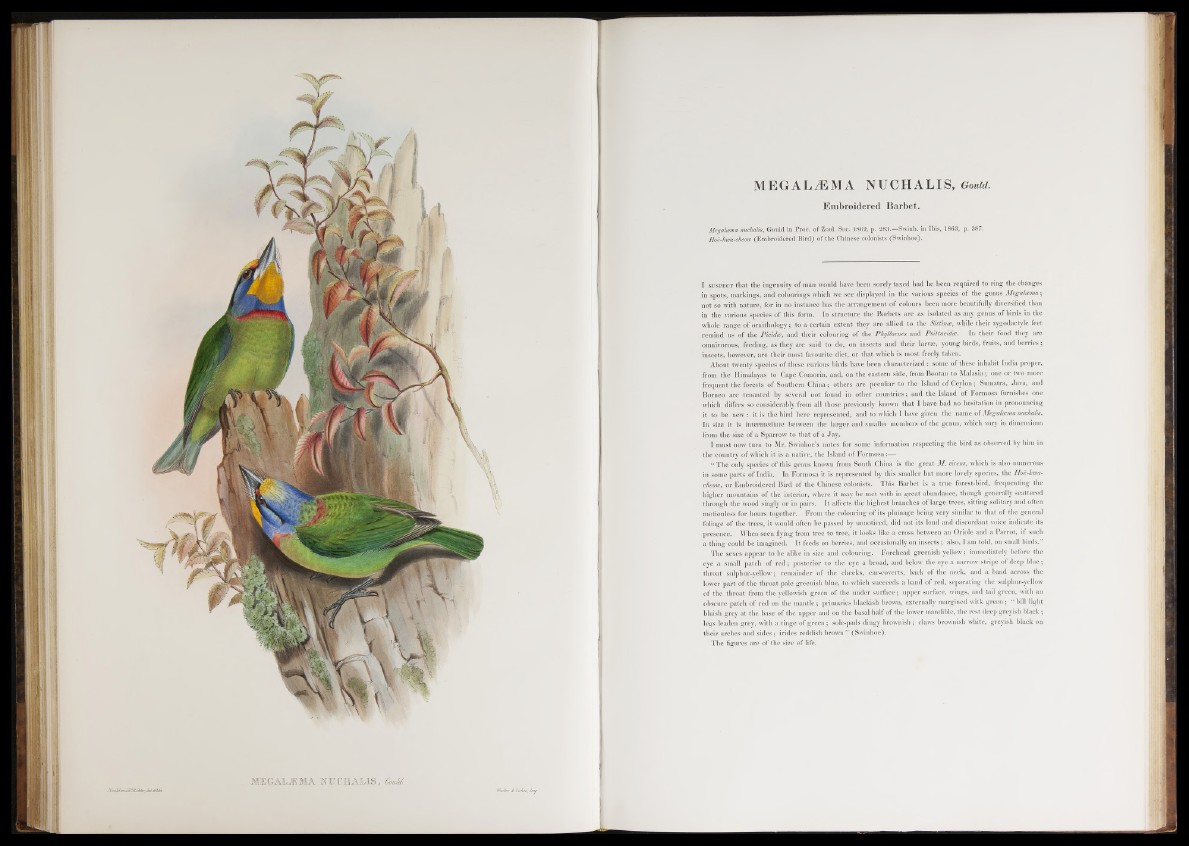
JGculdtndHCRiAUr dtlakth
ME GAL JE MA NUCHALIS, M
fi'aüer & Go Am, J/rw.
MEGALJ1MA NUCHALIS , Gould.
Embroidered Barbet.
Megalama nuchalis, Gould in Proc. of Zool. Sog. 1862, p. 283.—Swinh. in Ibis, 1863, p. 387.
Hoe-kwa-cheow (Embroidered Bird) o f the Chinese colonists (Swinhoe).
I su spe c t tbat the ingenuity of man would have been sorely taxed had -he been required to ring the changes
in spots, markings, and colourings which we see displayed in the various species of the genus Megalama;
not so with nature, for in no instance has the arrangement of colours been more beautifully diversified than
in the various species of this form. In structure the Barbets are as isolated as any genus o f birds in the
whole range of ornithology; to a certain extent they are allied to the S it tints, while their zygodactyle feet
remind us of the Picidce, and their colouring o f the Phyllornes and Psittacida. In their food they are
omnivorous, feeding, as they are said to do, on insects and their larvse, young birds, fruits, and berries;
insects, however, are their most favourite diet, or that which is most freely taken.
About twenty species of these curious birds have been characterized: some of these inhabit India proper,
from the Himalayas to Cape Comorin, and, on the eastern side, from Bootan to Malasia; one or two more
frequent the forests of Southern China; others are peculiar to the Island o f Ceylon; Sumatra, Java, and
Borneo are tenanted by several not found in other countries; and the Island o f Formosa furnishes one
which differs so considerably from all those previously known that I have had no hesitation in pronouncing
it to be new: it is the bird here represented, and to which I have given the name of Megalama nuchalis.
In size it is intermediate between the larger and smaller members of the genus, which vary in dimensions
from the size of a Sparrow to that of a Jay.
I must now turn to Mr. Swinhoe’s notes for some information respecting the bird as observed by him in
the country of which it is a native, the Island of Formosa:—
“ The only species of this genus known from South China is the great M. viretis, which is also numerous
in some parts of India. In Formosa it is represented by this smaller but more lovely species, the Hoe-kwa-
cheow, or Embroidered Bird of the Chinese colonists. This Barbet is a true forest-bird, frequenting the
higher mountains of the interior, where it may be met with in great abundance, though generally scattered
through the wood singly or in pairs. It affects the highest branches of large trees, sitting solitary and often
motionless for hours together. From the colouring of its plumage being very similar to that of the general
foliage o f the trees, it would often be passed by unnoticed, did not its loud and discordant voice indicate its
presence. When seen flying from tree to tree, it looks like a cross between an Oriole and a Parrot, if such
a thing could be imagined. It feeds on berries, and occasionally on insects; also, I am told, on small birds.”
The sexes appear to be alike in size and colouring. Forehead greenish yellow; immediately before the
eye a small patch of red; posterior to the eye a broad, and below the eye a narrow stripe of deep blue;
throat sulphur-yellow; remainder of the cheeks, ear-coverts, back of the neck, and a band across the
lower part of the throat pale greenish blue, to which succeeds a band of red, separating the sulphur-yellow
o f the throat from the yellowish green of the under surface; upper surface, wings, and tail green, with an
obscure patch of red on the mantle; primaries blackish brown, externally margined witk green; “ bill light
bluish grey at the base of the upper and on the basal half of the lower mandible, the rest deep greyish black;
legs leaden grey, with a tinge o f green; sole-pads dingy brownish; claws brownish white, greyish black on
their arches and sides; irides reddish brown ” (Swinhoe).
The figures are of the size of life.